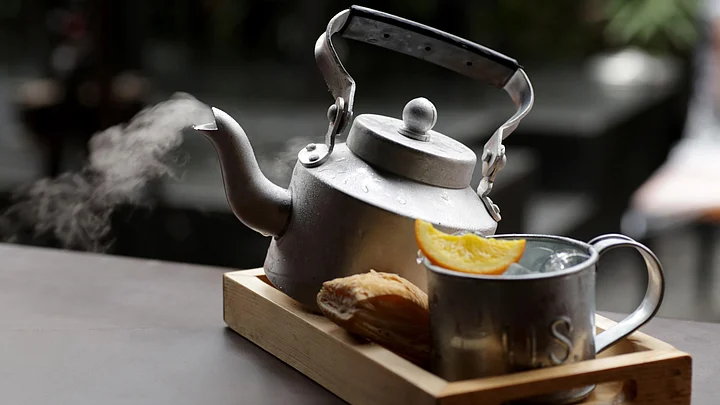Ever seen a tuft of harmless candy floss, which when placed in a martini glass, dissolves into a heady cosmopolitan? Ever imagined being able to bite into layers of jelli-fied vodka? Or even better, having intoxicating spaghetti shots?
Enticing to look at and exhilarating to taste, we get you the science behind these modern, molecular cocktails.
What are They?
Similar to the mini revolution that molecular gastronomy brought about for food, your average Joe drink is spruced up – and how – by the techniques of molecular mixology.
Molecular mixology plays with the flavours, textures, and ingredients of a drink to create a most dramatic effect. What’s interesting is that there is no significant difference in taste – but it is the entire drama of creating that cocktail, the whole visual appeal, that adds to the magic.
A molecular cocktail can be prepared in several different ways – using gels, powders, foams, atomised sprays, etc. These cocktails look very different from your regular martini glass as the very shape of the cocktail changes with the injection of chemicals.
The ‘Science’ Behind Them
Molecular mixology uses scientific methods for changing the molecular structure of alcohol. Just like water converts to ice at 0 degrees, similarly various ingredients change their state at certain temperatures. Alcohol may exist in the liquid state – but with an armoury of scientific concepts at a mixologist’s disposal, the latter can serve it in solid as well as gaseous forms.
Here are some popular techniques:
Smoked Cocktails: Take a cinnamon stick, burn it and invert a glass over it. Obviously, the flame will die out but you will be left with a smoky cinnamon fragrance.
Cocktail Gels (or Fancy Jell-O Shots): Unlike the traditional college jelly shots, the cocktail gels are made with perfectly crafted cocktails, unflavoured gelatin and impressive garnishes.
Molecular Caviars/Spheres/Raviolis: These are made using a combination of two edible chemicals – sodium alginate (align, a sea weed) and Gluco/calcium chloride. These can be added to champagne, cosmopolitans, margaritas, etc., to make them more interesting. One can also create a complete mojito cocktail inside a sphere.
Molecular Foams/Air: These are cocktails in gaseous form (foams), with the use of nitrous cylinder and foam gun. Examples include whisky sour with passion fruit foam, Cosmopolitans with watermelon and mint air – among others.
Grilled Cocktails: Did you know your favourite cocktails could be grilled?These are made using grilled fresh fruits and ingredients. Examples include grilled honey and lemon Caipiroska and grilled Bloody Mary.
Desert Molecular Cocktails: These include creations like Toblerone Sorbet (a mix of Baileys, Kahlua, Crème de cacao & Frangelico, turned into a sorbet using Liquid nitrogen) or Champagne sorbet (Champagne turned into a sorbet using liquid nitrogen).
Cafes that Whip up Unique Mixes
Mango Gin Spaghetti (Farzi Café, Gurgaon): This is prepared using the jellification technique. The end product actually looks like spaghetti pasta with a flavour of mango and gin.
B-52 sphere (Farzi Café): You couldn’t come across a more classic combination of flavours if you tried. A perfect layer shot, this is made with baileys, kahlua and orange liqueur. Specification is the name of the game – a technique used to make them into spheres. Funnily enough, the spheres look like egg yolks at the end of the process – yet, thankfully, taste nothing like one!
Cocktail Jelly (ARK, Courtyard by Marriott Mumbai): This edible jelly cocktail uses vodka as the first jelly base, Bailey jelly as the second base and kahlua as the third. You bite into this cocktail.
Cocktail Popsicles (Todi Mill Social, Mumbai): Colourful martini popsicles of various flavours – including apple, watermelon and sour cherry – are used to create these imaginative cocktails: Limoncello and Raspberry Whiskey Sour Popsicles.
Watermelon Martini with Vanilla Foam (Todi Mill Social, Mumbai): This is a freshly muddled watermelon and kaffir lime vodka base martini – topped with a Lecithin foam for a creamy head. This also complements the base flavour of the cocktail.
Flavoured Ice-Chamomile and Cranberry Cocktail (Todi Mill Social, Mumbai): This is made using ice cubes or spheres flavoured with cranberry and orange zest. As the ice melts, it releases the aromas and flavours of that ingredient into the chamomile-infused whisky cocktail instead of diluting it.
Potential Mixologists be Warned!
Molecular cocktails aren’t difficult to make but they are time consuming. Also, you have to be very careful with the proportion of chemicals as they can be harmful. Some methods like the flavoured ice or use of candy floss are easy to execute but when it comes to the use of chemicals or molecular equipments one needs to have the right skills, experience and proper education to get it just right!
(Expert inputs by Ami Behram Shroff, flair bartender and Nitin Tewari, Trade Ambassador, Bacardi India)
(A blog for the urban Indian, Lettuce Review aims at putting foodie tales and culinary travel stories from India on the global map. Follow them on @lettuce_review and say hello at lettucereview@gmail.com.)
(At The Quint, we question everything. Play an active role in shaping our journalism by becoming a member today.)
